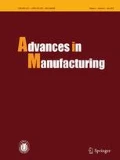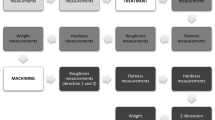Abstract
Large strain extrusion machining (LSEM) is a typical process for preparing ultrafine or nanocrystalline strips. It is based on large plastic deformation. The processing parameters of LSEM in this study were optimized by experiments and simulations. Using the orthogonal array, signal-to-noise ratio, and analysis of variance, the influence and contribution of processing parameters on response variables were analyzed. Because of the difference in processing parameters between optimizing the average grain size and the maximum temperature, the response variables analyzed must be correctly selected. Furthermore, the optimal processing parameters for obtaining the minimum average grain size and the lowest maximum temperature are analyzed. The results show that the tool rake angle is the most important factor. However, the level of this factor required to achieve the minimum average grain size is different from that required to obtain the lowest maximum temperature. The validity of the method is verified through experiments and simulations.





Similar content being viewed by others
References
Moscoso W, Shankar MR, Mann JB (2007) Bulk nanostructured materials by large strain extrusion machining. J Mater Res 22:201–205
Segal VM, Reznikov VI, Dobryshevshiy AE (1981) Plastic working of metals by simple shear. Russ Metall 1:99–105
Bridgman PW (1952) Studies in large plastic flow and fracture. New York: McGraw-Hill. USA. https://doi.org/10.4159/harvard.9780674731349
Vu VQ, Beygelzimer Y, Kulagin R et al (2018) (2018) Mechanical modelling of the plastic flow machining process. Materials 11:1218. https://doi.org/10.3390/ma11071218
Vu VQ, Beygelzimer Y, Toth LS et al (2018) The plastic flow machining: a new SPD process for producing metal sheets with gradient structures. Mater Charact 138:208–214
Swaminathan S, Ravi SM, Rao BC et al (2007) Severe plastic deformation (SPD) and nanostructured materials by machining. J Mater Sci 42:1529–1541
Sevier M, Yang HTY, Moscoso W et al (2008) Analysis of severe plastic deformation by large strain extrusion machining. Metall and Mater Trans A 39:2645–2655
Bai X, Kustas A, Chandrasekar S et al (2016) Large strain extrusion machining on 6013 aluminum alloy. In: Williams E (eds) Light metals 2016. Springer, Cham, Switzerland. https://doi.org/10.1007/978-3-319-48251-4_38
Efe M, Moscoso W, Trumble KP et al (2012) Mechanics of large strain extrusion machining and application to deformation processing of magnesium alloys. Acta Mater 60:2031–2042
Klenosky DR, Johnson DR, Trumble KP (2016) Application of secondary shear effects in the extrusion machining process to explore recrystallization mechanics during conventional extrusion of 7050 aluminum. Light Metals. https://doi.org/10.1007/978-3-319-48251-4_37
Kustas AB, Johnson DR, Trumble KP et al (2018) Enhancing workability in sheet production of high silicon content electrical steel through large shear deformation. J Mater Process Technol 257:155–162
Yin XL, Pi YY, He D et al (2018) Development of ultrafine grained Al 7075 by cryogenic temperature large strain extrusion machining. J Mater Res 33(20):3449–3457
Deng WJ, Xia W, Li C et al (2009) Formation of ultra-fine grained materials by machining and the characteristics of the deformation fields. J Mater Process Technol 209(9):4521–4526
Bertolini R, Bruschi S, Ghiotti A et al (2018) Large strain extrusion machining of magnesium alloys for biomedical applications. Procedia CIRP 71:105–110
Deng WJ, Lin P, Xie ZC et al (2012) Analysis of large-strain extrusion machining with different chip compression ratios. J Nanomater 11:5271–5282
Klenosky DR, Johnson DR, Chandrasekar S et al (2017) Characterization of large strain extrusion machining (LSEM) of AA7050. In: Ratvik A. (eds) light metals 2017. the minerals, metals & materials series. Springer, Cham, Switzerland, pp 301–304. https://doi.org/10.1007/978-3-319-51541-0_40
De Chiffre L (1976) Extrusion-cutting. Int J Mach Tool Manuf 16:137–144. https://doi.org/10.1016/0020-7357(76)90032-9
De Chiffre L (1983) Extrusion cutting of brass strips. Int J Mach Tool Manuf 23:141–151
SariKaya M, Güllü A (2014) Taguchi design and response surface methodology based analysis of machining parameters in CNC turning under MQL. J Clean Prod 65:604–616
Kechagias J, Vaxevanidis N (2012) Application of Taguchi design for quality characterization of abrasive water jet machining of TRIP sheet steels. Int J Adv Manuf Technol 62(5/8):635–643
Taguchi G (1990) Introduction to quality engineering. Asian Production Organization, Tokyo
Davim JP, Reis P, António CC (2004) A study on milling of glass fiber reinforced plastics manufactured by hand-lay up using statistical analysis (ANOVA). Compos Struct 64(3/4):493–500
Balaji M, Murthy BSN, Rao NM (2016) Optimization of cutting parameters in drilling of AISI 304 stainless steel using Taguchi and ANOVA. Proc Technol 25:1106–1113
Kechagias J, Petropoulos G, Vaxevanidis N (2012) Application of Taguchi design for quality characterization of abrasive water jet machining of TRIP sheet steels. Int J Adv Manuf Technol 62:635. https://doi.org/10.1007/s00170-011-3815-3
Qasim A, Nisar S, Shah A et al (2015) Optimization of process parameters for machining of AISI-1045 steel using Taguchi design and ANOVA. Simul Model Pract Theory 59:36–51
Camposeco NC (2013) Optimization of cutting parameters for minimizing energy consumption in turning of AISI 6061 T6 using Taguchi methodology and ANOVA. J Clean Prod 53(16):195–203
Zębala W, Kowalczyk R (2015) Estimating the effect of cutting data on surface roughness and cutting force during WC-Co turning with PCD tool using Taguchi design and ANOVA analysis. Int J Adv Manuf Technol 77(9/12):2241–2256
Johnson GR, Cook WH (1983) A constitutive model and data for metals subjected to large strains, high strain rates and high temperatures. In: Proceedings of the 7th international symposium on ballistics, Hague, Netherlands, pp 541–557
Acknowledgements
This research was conducted under the support of the National Nature Science Foundation of China (Grant No. 51375174), the Fundamental Research Funds for Central Universities (Grant No.2017ZD024), and the Natural Science Foundation of Guangdong Province (Grant Nos. S2013050014163, 2017A030313260).
Author information
Authors and Affiliations
Corresponding author
Rights and permissions
About this article
Cite this article
Pi, YY., Deng, WJ., Zhang, JY. et al. Towards understanding the microstructure and temperature rule in large strain extrusion machining. Adv. Manuf. 9, 262–272 (2021). https://doi.org/10.1007/s40436-020-00343-w
Received:
Revised:
Accepted:
Published:
Issue Date:
DOI: https://doi.org/10.1007/s40436-020-00343-w



